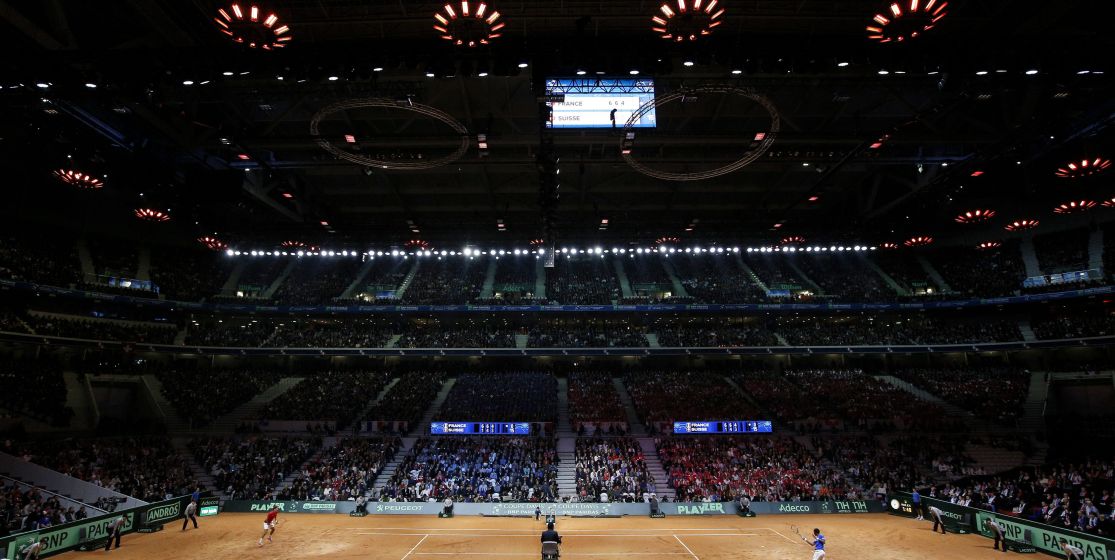If France’s choice to play it’s BNP Paribas Davis Cup’s first round in Guadeloupe has stimulated much attention from the press, it’s not among the most unusual places where a Davis Cup match has been played. Here they are.
The biggest : Grand stade de Lille
Just like Poland, who had used the Warsaw National stadium, traditionally dedicated to football, during the volleyball world cup, the latest trend seems to be using huge football stadiums to host other sport events. This is why the Grand Stade de Lille hosted the BNP Paribas Davis Cup final, between France and Switzerland. But the Stadium, which hosted a year later the Basketball european championship, didn’t bring luck to Arnaud Clément’s men as the Helvetians finally won 3-1, lifting the silver shield. All of that in front of 27 432 supporters ! A never-seen before attendance for a tennis match and a new record. The previous one was set in 2004, when Spain had chosen the Olympic Stadium of Sevilla and its 27 200 seats to face the USA. With more joy than France, as in that year, the Iberians had won.
The most olé: Plaza de toros de Cordoba
16 000 overexcited aficionados, a suffocating heat and a place where animals are traditionally put to death. Spain knows how to receive guests and decided to welcome France in the middle of the Plaza de toros in Cordoba, for the semi-final of the 2011 edition. In this mythical arena where the hero is generally named El Cordobès, the legendary local matador, Spain’s passes come one after another, exhausting the French. The toreador Nadal has fun with Gasquet (6-3, 6-0, 6-1), and the Frenchmen’s victory in the doubles is a brief window of respite before the final blow. Nadal, again, deals with Tsonga (6-0, 6-2,6-4). Like in Cabrel’s song, France bites the dust in Cordoba and will remember Andalusia for a long time. On her side, Spain gains confidence after this triumph and will overcome Argentina in the final, to lift another silver bowl.
.jpg)
The most historical : Arena of Nîmes
If the Spaniards are allowed to use their plazas de toros, the French can also host in their antique arena of Nîmes ! A setting as unusual as beautiful which hosted « les Bleus » three times. For two wins and one defeat. But the Arena will especially be remembered as the stage of a superb feat and a revelation. In 1991, France is facing Australia in the quarter final in Nîmes, and the wind is spinning in the Arena during this weekend of June. The French and the Australian are neck and neck, when, for the last singles match, Captain Noah decides to play his last card. His savior is a young 18-year old Tahitian, Fabrice Santoro, who writes the first page of his long career by defeating Wally Masur in four sets. That year, France will go on to win the final in Lyon.
Le most sinister : Estadio Nacional de Chile
In 1976, General Pinochet’s dictatorship has been leading Chile for three years with an iron fist, when the USSR is getting ready to fly to Santiago, the chilean capital, to face the locals in the semi-final of the BNP Paribas Davis Cup. The only trouble is that the Soviets, in order to protest against the dictatorship, decide to refuse to take part in the match, following what their football team had done two years earlier. As a result, Chile is declared winner by default, and prepares to take part in the first final in their history against Italy. The Italian come confident, with Adriano Panatta, who has just won Roland-Garros. On the tennis court of the Nacional Stadium, which was used as a concentration camp by the dictatorship, the Italian decide to mark the occasion. As they usually play in blue outfits, they choose to wear red, a color scorned by the General Pinochet, during the decisive doubles match. Which they win, leaving morality intact.
The oldest : Longwood Cricket Club
In 1899, Dwight Davis has an epiphany. That summer is held, in sailing, the America’s Cup, between the USA and the British Isles. Davis, then a fourth-year student at the prestigious Harvard University, decides to adapt the concept to tennis, his sport. No sooner said than done, as one year later, from August 7th to August 10th 1900n the Americans face the British in the classy settings of the Longwood Cricket Club in Boston. On the grass courts, the Americans win the 1st International Lawn Tennis Challenge. A competition which will later be renamed the BNP Paribas Davis Cup, in hommage to its founder, at his death in 1946. In total, 15 matches of the BNP Paribas Davis Cup have been held in Longwood ; the last one, in 1999, has seen Pat Rafter’s Australia defeat Pete Sampras’ USA.
The Highest : Quito Tennis Club
Ecuador is a modest nation considering the world tennis scale, however, it holds two records. The first one is the work of its standard-bearer, who was probably the greatest player in the history of his country, Nicolas Lapentti. Lapentti holds an unusual record : the highest number of five-set wins in the history of the BNP Paribas Davis Cup. 13 in total ! Most of the time, Lapentti would win his matches in Guayaquil, a port opened on Pacific Ocean, and the second biggest city of the country, where Ecuador would host most of it’s home matches. However, sometimes, the Ecuadorians could count on a massive ally : altitude. In fact, « la Tricolor » sometimes hosts its matches in Quito, its capital as well as being one of the highest cities in the world, at 2800 meters above sea level, at the Quito tennis y golf club. The last time that happened was against Romania in 2003. And despite this ally, the Romanians had finally won 3-2. They had the nerves !






